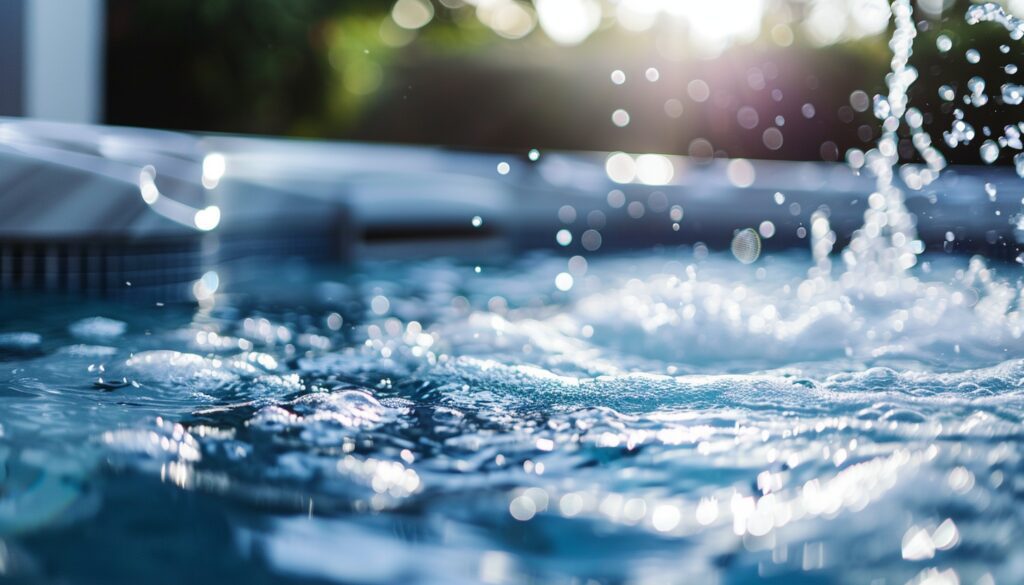Maintaining proper chlorine levels in your hot tub is crucial if you want it to remain safe and enjoyable. Chlorine is a sanitizer that keeps the water clean and free from harmful bacteria. However, adding too much chlorine can lead to skin & eye irritation, unpleasant odors, and potential damage to the hot tub components. This guide will help you quickly and effectively lower the chlorine levels in your hot tub, ensuring it remains a comfortable and safe environment.
The Quick Answer
If you need to quickly lower chlorine levels in your hot tub, use a chlorine neutralizer, dilute the water with fresh water, or leave the cover off and run the jets to let the chlorine dissipate. These methods can help reduce chlorine levels to the recommended range of 1-3 ppm.
Why It’s Important to Lower High Chlorine Levels
High chlorine levels in a hot tub can cause several problems that affect the hot tub and its users. Firstly, excessive chlorine can lead to skin and eye irritation, making the soaking experience uncomfortable. Prolonged exposure to high chlorine levels can cause dryness and redness, particularly for sensitive skin.
High chlorine levels are often associated with a strong, unpleasant “swimming pool” smell. This odor is caused by chloramines, which are byproducts formed when chlorine reacts with organic matter such as sweat, body oils, and other contaminants. Chloramines create a bad smell and reduce the effectiveness of chlorine as a sanitizer.
On top of that, high chlorine levels can damage the components of your hot tub. Chlorine is a powerful chemical that, in excess, can corrode metal parts, degrade plastic, and cause the vinyl cover to deteriorate. Maintaining the chlorine levels within the ideal range of 1-3 ppm helps protect your hot tub from unnecessary wear and tear.
Identifying High Chlorine Levels
Regular testing is essential to ensure your hot tub’s chlorine levels remain within the safe and effective range. Chlorine levels can be easily measured using test strips or liquid test kits. These tools provide a quick and accurate way to check the chlorine concentration in the water.
If you use your hot tub frequently, you should test the chlorine levels daily. Additionally, testing should be done after adding chemicals or following a shock treatment to ensure the levels have stabilized within the desired range.
When testing, dip the test strip into the water and compare the color change to the chart provided with the strips. A reading above three ppm indicates that the chlorine level is too high and needs to be lowered.
Three Ways to Lower Chlorine Levels
Lowering the chlorine levels in your hot tub quickly and effectively can be achieved in several ways. Each method has advantages and can be used depending on your specific situation and the urgency of reducing chlorine levels.
Method 1: Dilution
Instructions: Diluting the hot tub water is one of the simplest ways to lower chlorine levels. Remove a few buckets of water from the hot tub and replace it with fresh water. This will reduce the concentration of chlorine in the water.
Advantages: This method is quick, straightforward, and doesn’t require additional chemicals. It’s ideal if you have the time and are willing to add fresh water.
Steps:
- Turn off the hot tub and remove a few buckets of water.
- Refill the hot tub with fresh water.
- Turn the air jets on to circulate the water for 15 minutes.
- Test the chlorine levels again. If they are too high, repeat the process until the levels are within the safe range of 1-3 ppm.
Method 2: Chlorine Neutralizer
Instructions: A chlorine neutralizer is a fast and effective method to reduce high chlorine levels. Chlorine neutralizers are chemicals specifically designed to lower chlorine levels in water.
Advantages: This method is highly effective and quick, making it suitable for immediate use in the hot tub.
Steps:
- Add the chlorine neutralizer to the hot tub according to the manufacturer’s instructions.
- Turn on the jets to circulate the water for a few minutes.
- Retest the water to check the chlorine levels. Add more neutralizer if necessary until the chlorine level is within the desired range.
Method 3: Aeration and Sunlight
Instructions: Another natural way to lower chlorine levels is through aeration and exposure to sunlight. Running the air jets with the hot tub cover off lets chlorine dissipate faster.
Advantages: This method uses the hot tub’s existing features and doesn’t require additional chemicals. It’s particularly effective if you have a day or two before using the hot tub.
Steps:
- Remove the hot tub cover.
- Turn on the air jets to their highest setting.
- Allow the hot tub to run for several hours. If the hot tub is in a sunny spot, the sunlight will further help to break down the chlorine.
- Test the chlorine levels periodically to check if they have reached the safe range.
Preventing High Chlorine Levels
Preventing high chlorine levels in your hot tub is easier than correcting them once they occur. Regular maintenance and careful monitoring of chemical levels can help maintain a balanced and safe hot tub environment.
Regular Monitoring and Adjustment
- Test the chlorine levels regularly, ideally daily, to ensure they stay within the recommended range. Use test strips or a liquid test kit for accurate readings.
- Adjust the chlorine levels as needed based on the test results. If the levels are too high, use one of the methods described earlier to lower them.
Proper Dosing Techniques
- Follow the manufacturer’s guidelines for adding chlorine to the hot tub. Adding too much is a common cause of high chlorine levels.
- If you are using chlorine tablets, consider using a floating dispenser. This allows for a more controlled and gradual release of chlorine, reducing the risk of high levels.
Alternative Sanitizers
- Consider using bromine as an alternative sanitizer. Bromine is less harsh than chlorine and doesn’t produce the strong odor associated with chlorine. It’s also less likely to cause skin and eye irritation.
- Regularly shock the hot tub with a non-chlorine shock product to eliminate chloramines and maintain the sanitizer’s effectiveness.
Troubleshooting Common Issues
Persistent High Chlorine Levels
- Problem: Despite dilution and neutralization efforts, the chlorine levels remain high.
- Solution: If the chlorine levels are persistently high, it might be due to an incorrect measurement or an overlooked chemical reaction. Recheck the chlorine levels with a new test strip to ensure accuracy. If the reading is still high, try diluting the water further by removing more water and adding fresh water. It’s also helpful to leave the cover off and run the jets for an extended period, allowing the chlorine to dissipate naturally.
Chlorine Smell
- Problem: A strong chlorine smell persists even after adjusting chlorine levels.
- Solution: The chlorine smell is usually caused by chloramines, which form when chlorine reacts with organic matter. To break down chloramines and reduce the odor, shock the hot tub with a non-chlorine shock product. Leave the cover off during and after the shock treatment to ensure proper ventilation.
Component Damage
- Problem: High chlorine levels have caused damage to hot tub components.
- Solution: If components like headrests, covers, or metal parts show signs of damage, reduce chlorine levels immediately to prevent further degradation. Consider using a gentler sanitizer like bromine in the future. Regularly inspect and maintain the hot tub to catch any damage early and replace damaged parts as needed. If your spa needs repair, get in touch with a spa dealer that offers repair services, like us.
Final Thoughts on Quickly Lowering Hot Tub Chlorine Levels
Whether you choose to dilute the water, use a chlorine neutralizer, or rely on natural dissipation methods like aeration and sunlight, you now know how to achieve the ideal chlorine balance.
If you’re still interested in learning more about hot tub maintenance, check out some of our other recent blogs:







